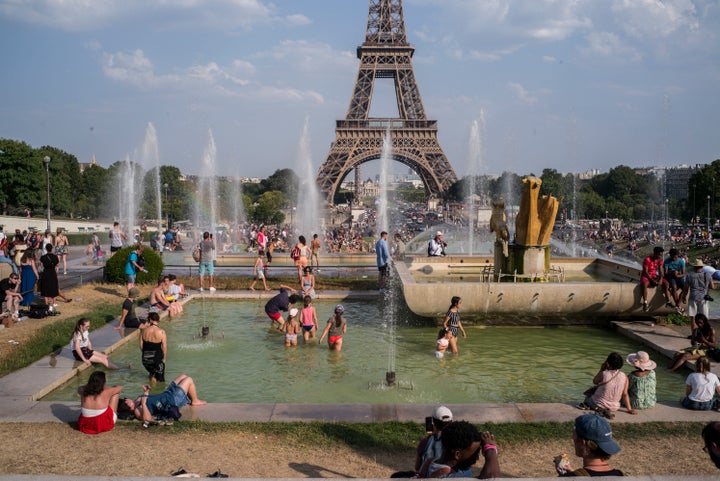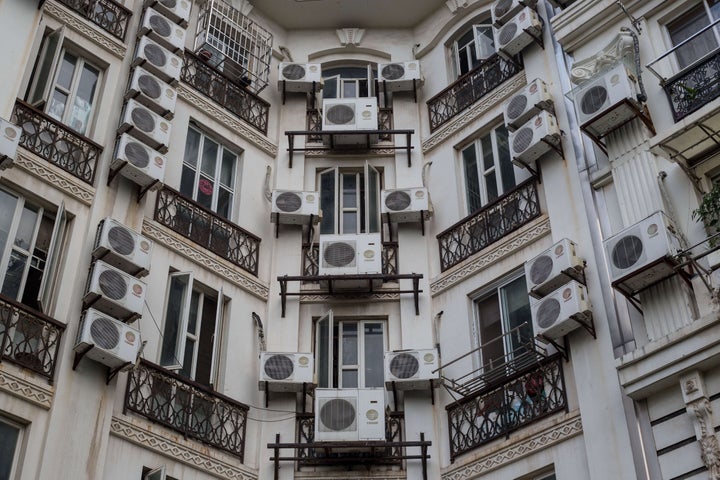When Alison Fullerton and her husband Jay lived in Europe for three years, it was gripped by a series of summer heatwaves. The couple ― who have since moved back to Tennessee ― bought a cute, portable air conditioner they called R2D2 because their house in Stuttgart, Germany, had no air conditioning.
“There was just an attitude that we all have to do our part to take care of mother earth,’’ Alison Fullerton said. “If we complained, they’d say, ‘It’s not bad. It’s only a couple weeks of the year.’ Americans want everything to be easy.”
Much of Europe, especially northern Europe, is notorious for its lack of air conditioning — notorious, at least, among the occasional Americans who book a trip during a summer heatwave and come to regret it.
These days, 90% of households have air conditioning in the U.S., where the high temperatures in southern areas can average over 90 degrees Fahrenheit in the summer. But with A/C, homes, office buildings, subways and shopping malls often remain icy. Meanwhile, across much of northern Europe, residents are accustomed to sweating indoors.
The U.S. had 374 million household air conditioners in 2016, according to the International Energy Agency (IEA), an intergovernmental research group. That’s 23% of the world’s installed air conditioners. Europe had 97 million ― 6% of the world’s total.
Green building executive Rick Fedrizzi saw — and felt — the difference firsthand when attending a meeting recently in a German office building where the room was about 80 degrees Fahrenheit. “The Germans were not complaining,’’ he said. “The Americans were doing anything to cool off, fanning themselves, drinking ice water, hoping the meeting would be over quicker.”
For many Europeans, A/C is just not part of the culture in the same way as it is in the U.S. Harry Koninis, a Greek marketing executive who recently moved to Bonn, Germany, has no air conditioning in his apartment or office and no plans to get any. “It’s not good for the environment. You also are spending a lot [of money] on energy,” he said, adding, “It’s almost unnatural to have such a cold temperature.”
But it appears that not everyone on the continent remains as resolute. As climate change makes scorching summers both more likely and more intense, there’s evidence that even Europe’s resolve against air conditioning may be breaking. Sales of air conditioners in France soared during a few hot days this June ― in the case of one large French retail chain, by 300% more than the same time last year ― according to retailers speaking to the local press.
The methods that Europeans have traditionally used to keep their buildings cool may not be enough against extreme heat. Concrete construction and stone buildings that are hundreds of years old are common throughout much of Europe. They stay cool if there’s only one hot day, but now that Europe is experiencing more frequent and prolonged high temperatures, the buildings retain the heat and don’t have the chance to cool down, explained John Dulac, an energy analyst at the IEA.
“If you have one hot summer, you may bear it,’’ he said. “When it starts happening every year, you’re more likely to go out and buy an A/C.”

July 2019 was the globe’s hottest month on record and August 2019 was the second hottest August on record, according to the European Union’s Climate Change Service. In Germany, where only 3% of households have air conditioners, it reached an all-time high of 108.7 degrees Fahrenheit this summer. Temperatures hit a record 114.6 degrees Fahrenheit in southern France, leading to more than 1,500 deaths, according to the country’s health minister.
With temperatures like these predicted to continue according to the European Environmental Agency, Europe is getting significantly more uncomfortable, even for Europeans. The IEA predicts that the total number of air conditioners in homes across the European Union will nearly triple by 2050.
“The irony is that increasing global demand for air conditioning threatens to worsen the very warming it is designed to combat.”
And it’s not just Europe. Since 1990, global sales of air conditioners have quadrupled to 135 million units per year, according to the IEA’s “Future of Cooling” report. Sales have been spurred by rising incomes across hotter countries in the developing world, such as India, Indonesia and Brazil, as well as extreme heat events. In China (current population: 1.4 billion), 5% of households had air conditioning 20 years ago and now 65% do, Dulac said.
The irony is that increasing global demand for air conditioning threatens to worsen the very warming it is designed to combat. Because the world uses fossil fuels for most power generation, greater use of air conditioning leads to even more greenhouse gases being released into the atmosphere, warming the planet and making the summers even hotter. A/C units also typically use as a refrigerant hydrofluorocarbons (HFCs), which are thousands of times more potent as a greenhouse gas than carbon dioxide.
Emissions from the widespread use of air conditioning also exacerbate air pollution, already responsible for more than 6 million deaths a year worldwide — more than AIDS, tuberculosis and malaria combined. In a study published last year in PLOS Medicine by the University of Wisconsin-Madison, researchers estimated that the additional emissions from energy used to drive air conditioners in a warming climate could cause 1,000 more air pollution deaths annually in the eastern United States alone by the middle of this century.
David Abel, lead author of that study, is not against air conditioning. It’s undeniable that it can protect people from heat-related illness and save lives. “We aren’t attacking air conditioning,’’ he said. “Air conditioning is extremely important in health and safety. But we can use and produce the energy that produces air conditioning more efficiently.”

That’s why, rather than fighting the trend toward more air conditioners, he and other groups such as the IEA are focused on lowering the amount of energy the devices gobble up. Without increased efficiency, the energy consumed by space cooling is expected to triple by 2050, warns the IEA.
In many cases, the organization says, people don’t buy the most efficient models, relying instead on machines that are only half as efficient as the best available technology. That’s because those models can be pricier and buyers don’t consider the lifetime savings relative to the upfront cost.
In the U.S., upgrading to a more efficient, Energy Star-rated air conditioner saves about $430 in energy costs over a 15-year lifespan, according to the U.S. Department of Energy’s Office of Energy Efficiency and Renewable Energy. Buying the most energy-efficient model, which uses 61% less energy than the least efficient, saves $1,530 over 15 years.
Around the world, governments setting energy-efficiency minimums could go a long way to reducing emissions, according to the IEA. That doesn’t have to mean more cost for businesses and individuals, Dulac said. The IEA has found that increased standards don’t necessarily lead to long-term price increases.
In fact, Dulac said, retail prices for some appliances have gone down as a result of increased innovation and manufacturers’ economies of scale. The United States increased efficiency mandates for household refrigerators in 1993 and 2001, and both times, the average price of refrigerators actually declined, according to the IEA.
“This is where the government has gone out and done good policymaking,’’ said Stephen Smith, executive director of the Southern Alliance for Clean Energy.
Many nations are already working to improve standards when it comes to the damaging refrigerants used in most air conditioners.
In 2016, more than 60 countries ratified the Kigali amendment to the Montreal Protocol to reduce HFCs used in refrigeration and air conditioning. The amendment went into effect in January of this year. Although the U.S. has not ratified it, several states, including California, are following its goals and phasing out the use of HFCs.
Individuals and businesses can do their part by buying more efficient air conditioning units and adopting technology that will reduce energy use. Programmable thermostats and smart devices such as Google’s Nest, which senses when you’ve left the house and turns down your air conditioner, are relatively low-cost ways to reduce consumption.

But not everyone around the globe has access to the latest technology, and much of the world’s economic development is occurring in places that don’t hold buildings’ energy use to high standards, according to the IEA.
While the IEA found that Europeans, on average, buy more efficient cooling equipment than people in other parts of the world (including the U.S.), there’s a lot of room for improvement. More worryingly, whatever Europeans do, the sheer numbers of people installing inefficient new air conditioners in countries such as China and India — projected to account for nearly half of all global household units by 2050 — could do irreparable harm to the environment.
“My fear is that rising temperatures, coupled with a rising standard of living in developing countries, is going to overwhelm that incremental gain we’ve made through technology,’’ Smith said. “If we remain addicted to fossil fuel, we are destined to fail.”
For more content and to be part of the “This New World” community, follow our Facebook page.
HuffPost’s “This New World” series is funded by Partners for a New Economy and the Kendeda Fund. All content is editorially independent, with no influence or input from the foundations. If you have an idea or tip for the editorial series, send an email to thisnewworld@huffpost.com.